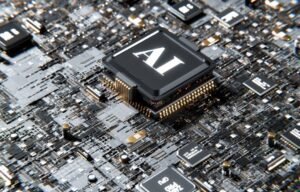Production of Bile
Bile is a greenish-yellow fluid that is produced in the liver and stored in the gallbladder. It plays a crucial role in digestion and the absorption of fats. Bile contains bile acids, cholesterol, bilirubin, water, electrolytes, and other organic and inorganic substances.
Key Takeaways:
- Bile is produced in the liver and stored in the gallbladder.
- It aids in the digestion and absorption of fats.
- Bile contains bile acids, cholesterol, bilirubin, and other substances.
Production Process
The production of bile begins in the liver cells called hepatocytes. These cells synthesize bile acids from cholesterol, a key component of bile. Bile acids are then conjugated with the amino acids glycine and taurine to form bile salts. These bile salts help emulsify fats, allowing them to be broken down further by enzymes in the digestive system.
*The liver produces approximately 600-1000 mL of bile each day, depending on the individual’s needs.*
Storage and Release
After being produced in the liver, bile is stored in the gallbladder, where it becomes concentrated. When we consume a meal that contains fats, the gallbladder contracts and releases the concentrated bile into the small intestine through the common bile duct. The release of bile is stimulated by the hormone cholecystokinin, which is released in response to the presence of fats in the small intestine.
Composition of Bile
Bile consists of water, electrolytes, bile acids, cholesterol, bilirubin, and other organic and inorganic substances. The primary components of bile are:
- Bile acids: These are derived from cholesterol and play a crucial role in fat digestion and absorption. They aid in the emulsification of fats, which increases their surface area for enzyme action.
- Cholesterol: Bile contains cholesterol, which is an essential component of cell membranes and is used to synthesize bile acids.
- Bilirubin: This yellow pigment is produced from the breakdown of old red blood cells and is excreted in bile. It gives bile its characteristic color.
Bile Production Disorders
Disruptions in the production, storage, or release of bile can lead to various medical conditions. Some common bile production disorders include:
- Gallstones: Hardened deposits that form in the gallbladder, often composed of cholesterol or bilirubin. They can block the bile ducts and cause pain or inflammation.
- Cholestasis: A condition characterized by the reduction or cessation of bile flow, leading to the accumulation of bile acids and bilirubin in the liver. This condition can be caused by various factors, such as liver disease or obstruction.
- Biliary atresia: A rare liver disease in infants where the bile ducts are inflamed or blocked, leading to bile flow problems and liver damage.
Tables
| Name | Function |
|---|---|
| Cholic Acid | Aids in fat digestion and absorption |
| Chenodeoxycholic Acid | Reduces cholesterol levels in the body |
| Deoxycholic Acid | Enhances the absorption of dietary fats |
| Component | Function |
|---|---|
| Bile Acids | Emulsify fats for digestion |
| Cholesterol | Component of cell membranes and bile acid synthesis |
| Bilirubin | Product of red blood cell breakdown, gives bile its color |
| Disorder | Description |
|---|---|
| Gallstones | Hardened deposits in the gallbladder, causing blockage and pain |
| Cholestasis | Reduction in bile flow, leading to build-up of bile acids and bilirubin |
| Biliary Atresia | Inflammation or blockage of bile ducts in infants |
Summary
The production of bile is a vital process in the human body, facilitating the digestion and absorption of fats. *Each day, the liver produces approximately 600-1000 mL of bile, which is stored in the gallbladder and released into the small intestine as needed.* Bile consists of bile acids, cholesterol, bilirubin, and other organic and inorganic substances. Disorders related to bile production can lead to various medical conditions. Understanding the role and composition of bile helps us appreciate its significance in maintaining a healthy digestive system.

Common Misconceptions
The Production of Bile
Despite being a vital component of our digestive system, there are several misconceptions surrounding the production of bile. Let’s debunk a few of these myths:
- Bile is produced in the liver: While it is true that bile is involved in the liver’s functions, bile itself is actually produced in the liver cells known as hepatocytes.
- Bile is only important for digestion: While bile does play a crucial role in breaking down fats during digestion, it serves other purposes as well. Bile helps in the elimination of waste products, such as bilirubin, from the body.
- Bile production is constant: Contrary to the belief that bile is produced continuously, bile secretion is regulated by the body’s demand for it. Bile production increases during a meal, aiding in the digestion and absorption of fats.
Bile is a complex fluid that performs various roles in our body. Understanding the facts about its production can help clarify common misconceptions and enhance our knowledge of the digestive process.
The production of bile is an intricate process that involves several key steps. Firstly, hepatocytes in the liver produce bile salts, which are essential for breaking down fats into smaller particles that can be absorbed by the body. These bile salts are then transported via small bile ducts to the gallbladder, where they are concentrated and stored until needed for digestion. When food reaches the small intestine, a hormone called cholecystokinin is released, which signals the gallbladder to contract and release bile into the intestine.
- Bile production is regulated by hormones: The release of bile is triggered by the hormone cholecystokinin, which is secreted in response to the presence of fat in the small intestine.
- The gallbladder stores bile: Bile is stored and concentrated in the gallbladder, allowing for its controlled release into the small intestine during digestion.
- Bile emulsifies fats: One of the primary functions of bile is to break down fats into smaller droplets, a process known as emulsification, to aid in their digestion and absorption.
In conclusion, understanding the production of bile is crucial for comprehending the digestive process and debunking common misconceptions. Bile not only aids in the digestion and absorption of fats but also plays a role in waste elimination from the body. By dispelling these misconceptions, we can enhance our knowledge of this vital component of our digestive system.

Introduction
The production of bile is an essential process in our bodies that aids in digestion and the absorption of nutrients. Bile is produced by the liver and then stored in the gallbladder before being released into the small intestine. In this article, we will explore various aspects of bile production and its importance in maintaining a healthy digestive system. The following tables provide interesting data and information related to this topic.
Table: Components of Bile
Bile is composed of several components that play distinct roles in the digestion process. This table showcases the composition of bile and the function of each component.
| Component | Function |
|————|————————–|
| Water | Dilutes and carries bile.|
| Bile salts | Aid in fat digestion. |
| Bilirubin | Helps remove waste. |
| Cholesterol| Facilitates bile formation. |
| Electrolytes| Maintain fluid balance. |
Table: Bile Production by the Liver
The liver is responsible for continuously producing and secreting bile. This table illustrates the approximate daily production of bile by the liver based on body weight.
| Body Weight (kg) | Bile Production (mL) |
|——————|———————-|
| 70 | 600-1000 |
| 55 | 480-825 |
| 80 | 680-1150 |
| 65 | 520-875 |
| 90 | 760-1300 |
Table: Role of Bile in Fat Digestion
Bile plays a crucial role in the digestion and absorption of dietary fats. This table highlights the process of fat digestion and the function of bile in this process.
| Step | Function of Bile |
|———————|——————————–|
| Emulsification | Breaks down fat globules into smaller droplets. |
| Lipase Activation | Activates lipase enzyme, breaking down fats into fatty acids. |
| Micelle Formation | Forms micelles to make fats more soluble for absorption.|
| Absorption | Enables the absorption of fatty acids and fat-soluble vitamins. |
Table: Bile Acid Circulation
Bile acids are continuously recycled to ensure efficient digestion. This table demonstrates the enterohepatic circulation of bile acids in the body.
| Process | Description |
|————————————|—————————————|
| Bile secretion | Bile acids are synthesized and secreted by the liver. |
| Intestinal absorption | Majority of bile acids are reabsorbed in the small intestine. |
| Portal circulation | The reabsorbed bile acids are transported back to the liver through the portal vein. |
| Hepatic reuptake and re-secretion | Bile acids are taken up by the liver, converted, and re-secreted into bile. |
Table: Bile Pigment Abnormalities
Disruptions in bile pigment metabolism can lead to various disorders. This table presents different abnormalities related to bile pigments.
| Abnormality | Description |
|————————–|————————————————-|
| Jaundice | Yellowing of the skin and eyes due to high bilirubin levels.|
| Gilbert’s syndrome | Mild elevation of bilirubin levels, often without symptoms. |
| Dubin-Johnson syndrome | Impaired secretion of bilirubin into bile. |
| Crigler-Najjar syndrome | Deficiency of enzyme responsible for bilirubin conjugation. |
Table: Bile and Gallstone Formation
Gallstones can form when there is an imbalance in the components of bile. This table explains the relationship between bile composition and gallstone formation.
| Bile Composition | Gallstone Formation |
|—————————|———————-|
| High cholesterol levels | Formation of cholesterol gallstones. |
| Insufficient bile salts | Formation of pigment gallstones. |
| Excessive bilirubin | Formation of mixed gallstones. |
Table: Bile in Waste Removal
Bile aids in the elimination of waste products from the body. This table explores the role of bile in removing various waste substances.
| Waste Substance | Bile Function |
|————————-|————————————-|
| Excess cholesterol | Eliminates cholesterol from the body.|
| Bilirubin | Removes bilirubin, a waste product of hemoglobin breakdown. |
| Drugs and toxins | Assists in excreting drugs and toxins through bile secretion. |
Table: Factors Affecting Bile Production
Various factors can influence the production of bile in our bodies. This table highlights some of the key factors and their impact on bile production.
| Factor | Effect on Bile Production |
|———————–|————————————————|
| Fasting | Reduces bile production. |
| High-fat diet | Increases bile production to aid in fat digestion.|
| Medications | Certain medications can affect bile production. |
| Hormonal changes | Hormonal fluctuations can impact bile production.|
Table: Bile and Vitamin absorption
Bile plays a crucial role in the absorption of fat-soluble vitamins. This table demonstrates the relationship between bile and the absorption of different vitamins.
| Fat-Soluble Vitamin | Bile Function in Absorption |
|———————|————————————————|
| Vitamin A | Aids in the absorption and transport of Vitamin A.|
| Vitamin D | Enhances the absorption of Vitamin D. |
| Vitamin E | Facilitates the absorption of Vitamin E. |
| Vitamin K | Essential for the absorption and utilization of Vitamin K.|
Conclusion
Bile production is a complex process that involves multiple components and functions. Through the tables presented in this article, we have explored various aspects of bile production and its vital role in digestion, waste removal, and nutrient absorption. Understanding the significance of bile and its functions enhances our knowledge of the intricate workings of the human body and highlights the importance of maintaining a healthy digestive system.
Frequently Asked Questions
What is the role of bile in the digestive system?
Bile plays a crucial role in the digestive system as it assists in the breakdown and absorption of fats. It helps emulsify large fat molecules into smaller droplets, making it easier for enzymes to break them down. Bile also aids in the absorption of fat-soluble vitamins.
Where is bile produced?
Bile is produced in the liver. The liver cells, specifically hepatocytes, synthesize bile using cholesterol as a major component.
What is the pathway of bile production?
Bile production begins in the liver, where hepatocytes produce bile. It then travels through tiny bile ducts within the liver, eventually merging into larger ducts known as the common hepatic duct. From there, bile flows into the gallbladder, where it is stored and concentrated. When needed, the gallbladder releases bile into the small intestine through the common bile duct.
What are the main components of bile?
Bile is composed of water, bile salts, bilirubin, cholesterol, and other organic and inorganic compounds. Bile salts aid in the digestion and absorption of fats, while bilirubin gives bile its yellowish color.
How is bile production regulated?
Bile production is regulated by several factors. The hormone cholecystokinin, released by cells in the small intestine, stimulates the secretion of bile from the gallbladder. In addition, the bile salt synthesis in the liver is influenced by feedback mechanisms involving the enterohepatic circulation. This circulation system aids in the reabsorption of bile salts by the liver, which helps regulate their concentrations.
What happens if the production of bile is impaired?
If the production of bile is impaired, it can lead to various health conditions. One common example is cholestasis, which occurs when bile flow is blocked or reduced. This condition can cause jaundice, itching, and poor fat absorption.
Can the production of bile be affected by diet?
Yes, diet can have an impact on bile production. Consuming a diet high in saturated fats or cholesterol may increase the production of bile to aid in their digestion and absorption. On the other hand, a diet low in fats may result in reduced bile production.
Is bile continuously produced by the liver?
Yes, bile production is a continuous process carried out by the liver. The liver produces bile even when it is not actively being released into the small intestine.
What is the function of the gallbladder in bile production?
The gallbladder acts as a storage organ for bile. It concentrates the bile by removing water and electrolytes, and also releases it into the small intestine when needed for digestion.
Can the production of bile be affected by liver diseases?
Yes, liver diseases such as hepatitis, cirrhosis, or liver damage can disrupt the production and secretion of bile. This can lead to problems with fat digestion, absorption, and overall digestive function.




